When to plant cabbage seedlings in open ground
Planting cabbage seedlings in open ground begins in late April and continues until the last ten days of May, depending on the growing region and the variety of cabbage. The air temperature is at least 15 degrees.
NOTE. Cabbage seedlings should have 3 pairs of true leaves. The seedlings themselves must be strong and healthy.
Also, when choosing a specific date for sowing plant seeds and planting cabbage seedlings, you need to focus on the lunar calendar.
Proper watering
70% of caring for white cabbage in open ground consists of proper planning of watering that corresponds to the development phases of the cabbage inflorescence. Until the seedlings have formed a full-fledged root system, watering is carried out daily, using 100-150 ml of water per hole. We must not forget about proper shading of the area so that the liquid does not evaporate too quickly.
Between the formation of a full rosette of leaves and the formation of a head of cabbage, in the flowering state of the seedlings, caring for the plant requires regular watering while maintaining soil moisture at 80%. When the heads of cabbage have set and the process of growth of the cabbage head has begun, the frequency of watering is slightly reduced, to 70%. In mid-June (12-15 days before harvest), any artificial watering stops.
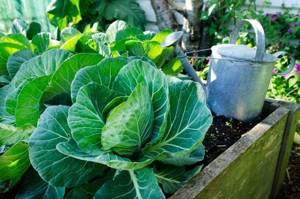
It is a big mistake during the period when the cabbage is blooming and the head of cabbage is just beginning to set, to stop regular watering and organize care by rare but abundant watering of the bed on the rare days of being at the dacha. This irrational distribution of moisture is seen as the reason for the rapid growth of the root system, to the detriment of the development of the inflorescence. We must not forget that cabbage loves moisture, as long as it is freely absorbed into the soil. Cabbage does not grow long in stagnant water and soon rots.
How to choose the time for planting seedlings depending on the region
In different regions, warm weather occurs at different times. Let's look at when to plant this crop in Russia.
FOLK SIGN. Cabbage seedlings should be planted after the bird cherry blossoms.
Central Black Earth Region
In this region, cabbage seedlings can be planted starting from the last ten days of April, adjusting the specific date in accordance with the established weather and the lunar calendar.
South of Russia
In the southern regions, cabbage seedlings are brought to a permanent place starting in April.
Ural and Siberia
In the Urals and Siberia, planting seedlings should be planned after mid-May. In a good year, seedlings can be transplanted even on the May holidays.
Moscow and Moscow region
In the capital region, seedlings can be planted from the beginning of May (early varieties) until the end of the month (late varieties).
How to sow cabbage seeds in open ground step by step
Let's consider a detailed algorithm for sowing cabbage seeds directly into open ground without growing seedlings.
How to treat planting material before planting
First of all, cabbage seeds need to be soaked in a solution of hydrogen peroxide for a day. This will help the grains germinate faster.
BY THE WAY. Using peroxide as the soaking liquid will eliminate the need to pickle the beans again. Peroxide will destroy all harmful elements on the outer shell of the seed.
How to choose the right variety
It is better to take several varieties of cabbage. Early ripening varieties are planted early. They can survive light frosts, but do not store well. Late-ripening ones are usually harvested after the first spring frost. Mid-season varieties are eaten after harvesting.
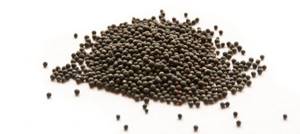
Seeds
Thus, having planted several varieties of the crop, you can leave a few heads of cabbage for storage and eat the rest.
At what depth to plant seeds?
Seeds are sown to a depth of no more than 3 cm. Fertilizer (compost or a pinch of monophosphate) can also be placed at the bottom of the holes. The planting hole must be moistened so that the seeds germinate faster.
What to do after cabbage seeds sprout
When the first cabbage shoots appear, they can be covered. To do this, use agrofibre or ordinary halves of plastic bottles.
But this is a completely optional procedure. In good weather, cabbage seedlings grow well even without shelter.
At first, it is important to regularly water the seedlings and weed the beds. Also, the next day after watering, you need to carefully loosen the soil.
How to care for cabbage seedlings in open ground
When the shoots appear, some of them will be next to each other. You can simply thin them out, or you can plant good seedlings.
When the seedlings grow a little, they need to be hilled. This procedure must be carried out regularly. This will make the plant more resilient. In addition, moisture will be better retained in the mound.
Don't forget to water the seedlings regularly. This should be done in the evening. In the morning you can loosen the soil.
It is also important to protect plantings from pests: cabbageweed, flea beetles and slugs. If you spray with insecticides or fungicides, do not forget to add soap to the solution. Solutions stick very poorly to cabbage leaves.
How to feed seedlings in open ground
The planted plants can be fed with nitroammophoska for the first time. This is a complex fertilizer that will saturate the seedlings with all the necessary microelements. A tablespoon per bucket of water is enough.
Cabbage pests and how to deal with them
Cabbage, like any vegetable in the garden, is attacked by various pests and diseases. Timely measures will help protect and preserve the harvest.
Cabbage pests
In order for pest control to be effective, analytical work will have to be carried out in advance. It is more effective to unite parasites according to some criteria and fight them comprehensively. The most common cabbage pests are:
- Aphid. It spreads in June and August. Plants need to be treated during these periods. The pest sucks the juices out of the vegetable, causing its growth to slow down.
- Thrips. Small insects suck the juices from the leaves and leave a huge amount of excrement. A sign of activity are white spots on the leaves.
- Bedbugs. They also suck out vital juices. The larvae are especially harmful, as they completely destroy the plant.
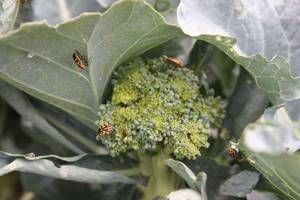
All these insects are sucking. Cabbage is also affected by gnawing insects, including:
- Cabbage fly. At the end of spring, the insect lays eggs, from which larvae emerge a week later. They live in the roots and stem, cutting cabbage seedlings at the root. The plant slowly withers, the roots rot.
- Fleas;
- Cabbage moth;
- White butterfly;
- Scoop.
Caterpillars of white moths, cutworms and cutworms chew holes in leaves, destroying plants and turning them into feed for livestock.
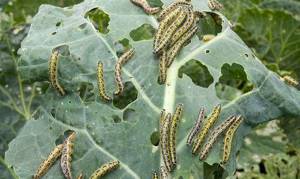
White butterfly caterpillars on cabbage
Wireworms and mole crickets also mow down cabbage seedlings. White cabbage and cauliflower can be nibbled by slugs and snails in garden beds. They crawl out at night. In the morning, only the eaten edges of the leaves remain.
Another reason for crop failure may be hares if there is a forest near the site. Long-eared animals love to visit vegetable gardens and nibble on cabbage. To prevent this, you can take the following measures:
- the fence should be additionally reinforced with chain-link mesh;
- attach spruce or pine branches to the fence;
- coat the tree trunks around the perimeter of the area with a mixture of clay and mullein in equal parts, a tablespoon of carbolic acid and 50 g of creolin in two buckets of water. The pungent smell will scare away hares.
Treating cabbage against pests
In general, when growing cabbage in the ground, you cannot treat it with chemicals, since the head of cabbage is tightly tied, and it will not be possible to wash off the chemicals in the future. You can use the drugs only until the head of cabbage is tied. Spray the leaves and soil around with contact and systemic agents. Experts recommend solutions:
- Aktellika,
- Aktars,
- Decisa,
- Iskra-M,
- Bankol,
- Fury.
If you spray the soil around the cabbage, the flea beetles will disappear. But after 2-3 weeks of the growing season, other control methods are used.
Biological products are less dangerous for humans and animals. They have neurotoxic effects on pests. These include:
- Verticillin for aphids and whiteflies;
- Antonem-F against nematodes, thrips, flies, wireworms, mole crickets and locusts;
- Bicol for aphids and bedbugs;
- Metarizin for nematodes;
- Aktofit destroys gnawing and sucking insects.
All these drugs can be combined into one mixture and provide comprehensive protection against pests. In addition, they are washed off during rains and watering, since they must be processed frequently. They work at temperatures from +18-19, so the treatment is carried out in late spring or early summer, when the weather is warm.
Traditional methods for controlling cabbage pests
These are safer methods of controlling cabbage pests. You can control pests using:
- valerian solution;
- decoctions of sage, mint, cilantro, fennel, parsley, calendula;
- ash, mustard powder or tobacco are sprinkled on the leaves and soil around;
- soap solution against aphids, read other ways to combat aphids here;
- soda for caterpillars;
- ammonia or vinegar several times a season to repel slugs and snails.
Also, to prevent the larvae from getting out of the soil, it can be mulched with non-woven material or wormwood.
How to choose a place for planting and planting cabbage
To get a good harvest of heads of cabbage, you need to choose the right place to plant the crop. Cabbage loves sunlit places. The absence of pests such as wireworms and weeds is also very important for it.
In addition to the above points, it is very important to choose the right soil and plant the crop after the right predecessors, which did not deplete the soil and did not leave behind pests and spores of fungal diseases that are dangerous for cabbage.
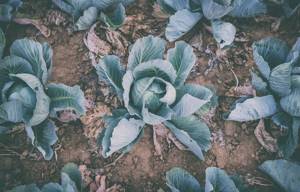
At what distance from each other should I plant cabbage?
When planting seedlings or sowing seeds directly into the ground, it is necessary to take into account that the cabbage will grow and spread its leaves. If you take good care of the seedlings, the heads of cabbage will be large, which means that the lower leaves will spread out very widely. If you plant plants too close to each other, then in the future the seedlings will not have enough space to grow and they will shade each other.
Early varieties and small hybrids of white cabbage are planted at a distance of 40 cm from each other. Mid-season and late varieties are planted further - at a distance of 70 cm from each other.
We’ll talk about the distance between seedlings and seeds of other varieties a little later.
Cabbage planting dates
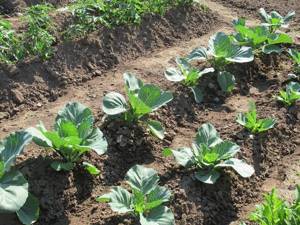
By the time white cabbage is planted in the garden, it should reach the desired height. The optimal height for early cabbage is 13–15 cm and at least 5–6 leaves. Medium and late cabbage varieties should have 6 to 7 leaves and a height of 15 to 20 cm.
Planting cabbage seedlings in the ground at the following times:
- early in early May
- late varieties in mid-May
- mid-season varieties early June
Is it possible to deepen stretched cabbage seedlings?
If your cabbage seedlings, which you want to plant in open ground, have stretched out, then they can be slightly deepened. Deepening should be carried out until the first true leaf.
This simple agrotechnical technique will allow the seedling to form additional roots and increase its mass.
ON A NOTE. Prepare for the fact that the deep seedlings will be slightly behind in development. This is normal, since such a seedling will first grow new roots and only then begin to grow the above-ground part.
Features of planting different types of cabbage
Now let's talk about some of the nuances of planting cabbage seedlings of different types.
Planting cauliflower
Cauliflower does not grow very much, so when planting it you can save a little space. Plant seeds or seedlings at a distance of 0.2-0.3 m from each other with a row spacing of up to 0.5 m.
When and how to plant Brussels sprouts
The Brussels variety needs a little more room to grow. Plant it so that there is at least half a meter between plants.
IMPORTANT! This variety does not like feeding with manure.
Planting Chinese cabbage seedlings in open ground
The distance between plants is 25 cm. But, if you grow this variety for greens, then sow it in rows (3 per bed). Chinese cabbage also loves mulching.
Planting white cabbage
The cabbage planting depth is 5 cm. You can dig a common trench, or you can dig individual holes. The bottom of the planting hole is watered and allowed to soak in.
In order for the seedlings to take root better, you can pour a matchbox of monophosphate onto the bottom of the hole before planting. Organic fertilizers include rotted manure, compost or green manure. The norm is 500 g per well.
Next, we plant the seedlings, deepening them a little. We crush the soil so that there are no voids.
How to plant savoy cabbage
Savoy cabbage is planted in the same way as the white cabbage we are used to. Moreover, this variety even prefers the same fertilizers. This means that it is convenient to plant it together with white cabbage.

Planting kohlrabi
Kohlrabi seedlings are planted when the seedling has 2 pairs of leaves. The distance between seedlings when planting should be about 60 cm. Smaller varieties can be planted closer to each other, larger ones, on the contrary, further away from each other.
Feeding base
How to grow white cabbage without using nitrates and growth accelerators? In parallel with the first loosening and hilling, the seedlings are fed with organic fertilizer. Use chicken manure diluted with water in a concentration of 1 dry matter, 15 glasses of water. The liquid is poured into a small watering can with the diffuser removed and, carefully, lifting the leaves, the fertilizer is introduced into each hole. It is advisable to do this immediately after watering so that the solution “disperses” in the top layer of soil and does not soak into the depths.
See also
How often should you water cabbage in open ground and with what waterRead
After 14 days, the seedlings are fed with 10% mullein infusion, which was diluted and left to infuse 10 days before use. It is also used to water the sprouts when the fruits begin to set.
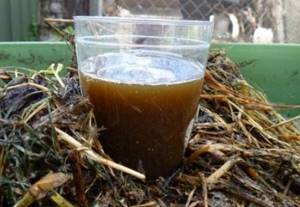
For supporters of mineral fertilizers, the feeding scheme for cabbage is different. On the 14th day from planting in the ground, make a solution from the following components:
- 10 g urea;
- 20 g superphosphate;
- 15 g of potassium chloride.
This dry mixture is dissolved in a bucket of water and poured into a specially dug groove exactly between the rows, which is then backfilled. 21 days after the first procedure, when the heads of cabbage have already set, a similar portion is prepared from the above elements and the whole process is reproduced exactly.
20-30 days before cutting the heads of cabbage, nitrogen fertilizers are stopped applied to the soil and watering is limited or completely stopped.
Foliar feeding is used for late seedlings if the sprouts are weak, have stopped growing or have turned yellow. The solution is prepared based on four liters of water (or half a bucket) and take for it:
- 1 kg potassium chloride;
- 70 g double superphosphate;
- 10 g molybdenum.
The composition for foliar feeding is infused for 24 hours and then used for irrigation from a household sprayer.
Tricks for planting and planting cabbage in open ground
Now let's talk a little about the secrets of experienced summer residents.
- In order for cabbage to take root better, the planting area needs to be processed: dug up, loosened, leveled and all weeds removed.
- Planting seedlings is the most optimal, since in this way the plants take root better and begin to bear fruit faster.
- Sowing seeds is the easiest way, as there is no need to grow seedlings. This way you get a later harvest of vegetables.
- In order for the seedlings to take root better, a mixture of 300 grams of rotted manure and 30 grams of monophosphate is placed at the bottom of the hole. Then a small amount of soil is poured on top of the fertilizer and only then the seedlings are planted.
- In the first weeks after planting seedlings, irrigation is carried out frequently, but in small doses - once every 3 days, 4 liters of water. Then the frequency of watering is reduced to 1 per five-day period, but the water consumption rate is increased to 10 liters. The next day, the soil under the cabbage is loosened.
- Plant several varieties of different cabbage (early, mid-season, late). This way you are guaranteed to get a harvest of vegetables.
- You should not feel sorry for frail and non-growing seedlings. Feel free to remove them so that they do not interfere with healthy plants.
Common mistakes
Let's look at the mistakes that summer residents most often make when planting cabbage.
- Poorly prepared planting material. This applies to both seeds and seedlings. The seeds must be treated and germinated, and the seedlings must be hardened and have 3 pairs of leaves.
- Poorly chosen location. Cabbage should be planted in free space with access to the sun.
- Planting too often. This culture needs room to grow. Placing plants too close will not allow you to get normal yields even if you take good care of the plants.
- Irrigation with water from a well or water supply. In principle, cabbage, especially grown plants, can be watered directly from a hose. But it is better to irrigate young seedlings with warm, settled water.
- Lack of feeding. To make the seedlings take root better, add ash, monophosphate or humus to the bottom.
Cabbage diseases
What else is involved in growing and caring for white cabbage? Of course, in protecting the plant from various diseases and in urgently taking measures when they are detected. In central Russia, the most common pathological conditions of this vegetable are:
- Clubroot is a fungus that develops in the root system when there is excess moisture. Characterized by growths and swelling of individual rhizomes. There are still no remedies against clubroot, so you just need to find the diseased plant and remove it from the garden bed, and treat the soil with formaldehyde;
- White rot is expressed by a weeping white coating that occurs due to a lack of phosphorus and potassium fertilizers. To prevent the disease, it is enough to follow the feeding schedule;
- Fusarium - detected by a brown ring-shaped pattern on a cut of cabbage leaf petiole. Fusarium cannot be cured - the plant is dug up and the planting site is sprayed with furatsilin.
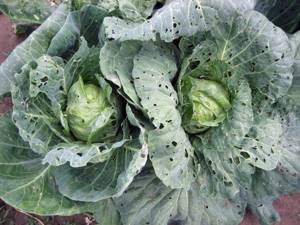
Answers to frequently asked questions
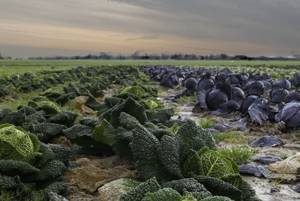
When to plant cabbage?
As soon as it gets steadily warmer to +15. You can plant seedlings, or you can sow seeds.
Which cabbage is best to plant?
Choose several varieties and varieties to ensure you get the best harvest.
Do you need to mulch cabbage beds?
It definitely won't hurt. And mulch will help retain moisture at the roots longer.











